engine Citroen NEMO 2011 1.G Service Manual
[x] Cancel search | Manufacturer: CITROEN, Model Year: 2011, Model line: NEMO, Model: Citroen NEMO 2011 1.GPages: 180, PDF Size: 9.06 MB
Page 152 of 180
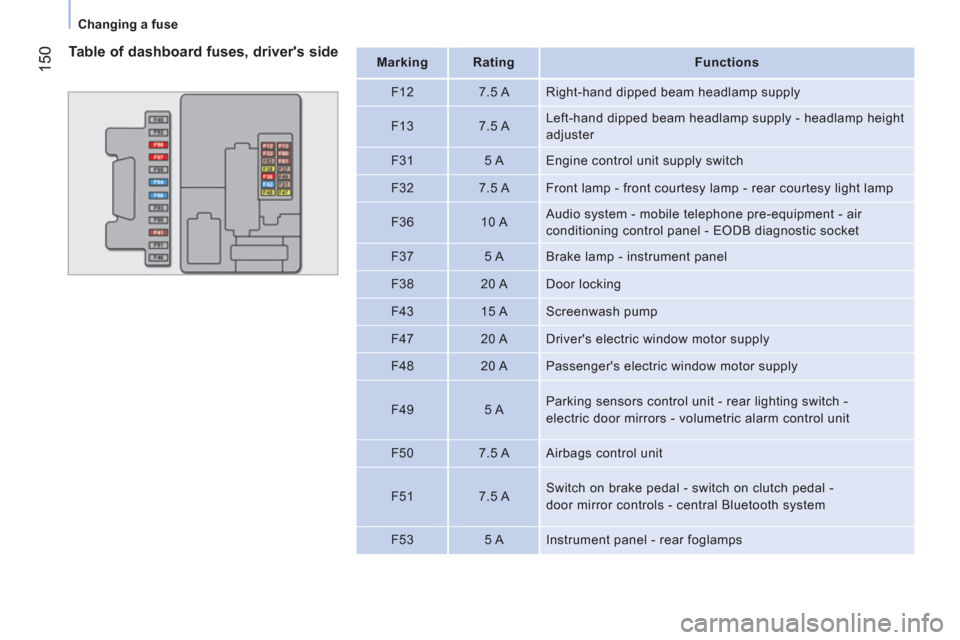
150
Changing a fuse
Table of dashboard fuses, driver's side
Mark
ing
Rating
Functions
F12
7.5 A Right-hand dipped beam headlamp supply
F13
7.5 A Left-hand dipped beam headlamp supply - headlamp height
adjuster
F31
5 A Engine control unit supply switch
F32
7.5 A Front lamp - front courtesy lamp - rear courtesy light lamp
F36
10 A Audio system - mobile telephone pre-equipment - air
conditioning control panel - EODB diagnostic socket
F37
5 A Brake lamp - instrument panel
F38
20 A Door locking
F43
15 A Screenwash pump
F47
20 A Driver's electric window motor supply
F48
20 A Passenger's electric window motor supply
F49
5 A Parking sensors control unit - rear lighting switch -
electric door mirrors - volumetric alarm control unit
F50
7.5 A Airbags control unit
F51
7.5 A Switch on brake pedal - switch on clutch pedal -
door mirror controls - central Bluetooth system
F53
5 A
Instrument panel - rear foglamps
Page 154 of 180
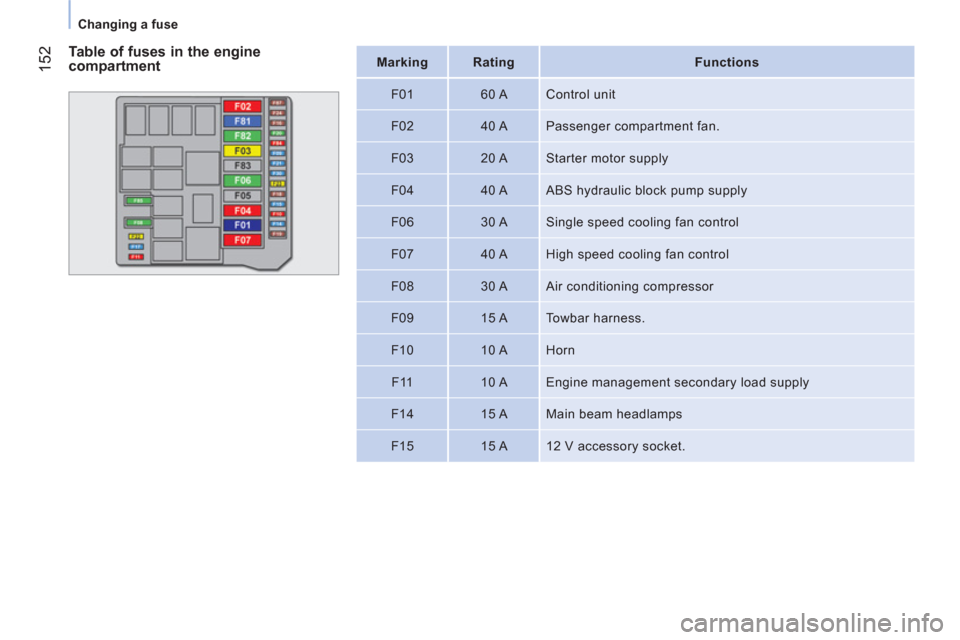
152
Changing a fuse
Mark
ing
Rating
Functions
F01
60 A Control unit
F02
40 A Passenger compartment fan.
F03
20 A Starter motor supply
F04
40 A ABS hydraulic block pump supply
F06
30 A Single speed cooling fan control
F07
40 A High speed cooling fan control
F08
30 A Air conditioning compressor
F09
15 A Towbar harness.
F10
10 A Horn
F11
10 A Engine management secondary load supply
F14
15 A Main beam headlamps
F15
15 A 12 V accessory socket.
Table of fuses in the engine
compartment
Page 155 of 180
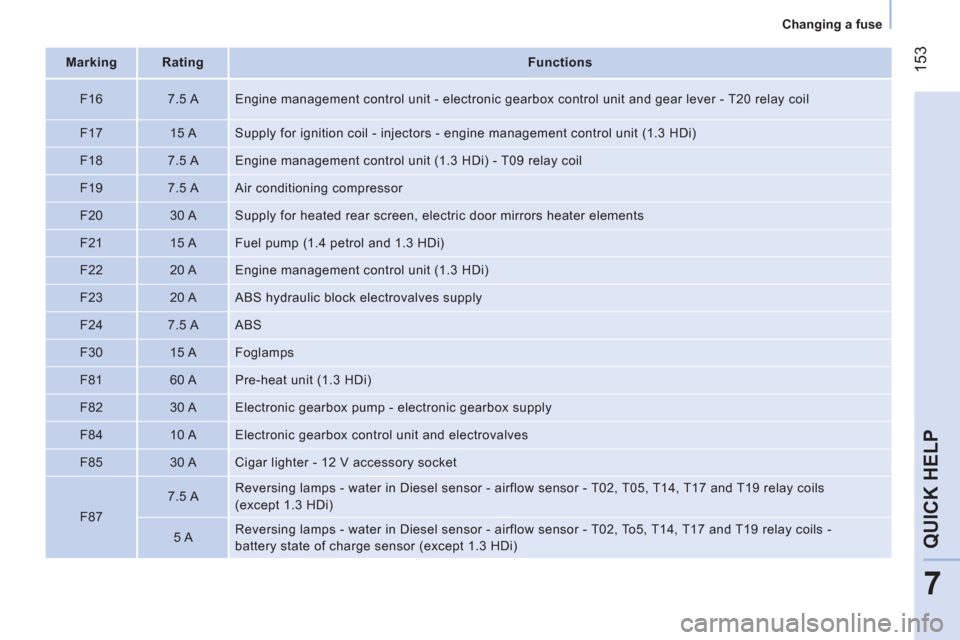
153
7
QUICK HELP
Changing a fuse
Marking
Rating
Functions
F16
7.5 A Engine management control unit - electronic gearbox control unit and gear lever - T20 relay coil
F17
15 A Supply for ignition coil - injectors - engine management control unit (1.3 HDi)
F18
7.5 A Engine management control unit (1.3 HDi) - T09 relay coil
F19
7.5 A Air conditioning compressor
F20
30 A Supply for heated rear screen, electric door mirrors heater elements
F21
15 A Fuel pump (1.4 petrol and 1.3 HDi)
F22
20 A Engine management control unit (1.3 HDi)
F23
20 A ABS hydraulic block electrovalves supply
F24
7.5 A ABS
F30
15 A Foglamps
F81
60 A Pre-heat unit (1.3 HDi)
F82
30 A Electronic gearbox pump - electronic gearbox supply
F84
10 A Electronic gearbox control unit and electrovalves
F85
30 A Cigar lighter - 12 V accessory socket
F87
7.5 A Reversing lamps - water in Diesel sensor - airflow sensor - T02, T05, T14, T17 and T19 relay coils
(except 1.3 HDi)
5 A Reversing lamps - water in Diesel sensor - airflow sensor - T02, To5, T14, T17 and T19 relay coils -
battery state of charge sensor (except 1.3 HDi)
Page 156 of 180
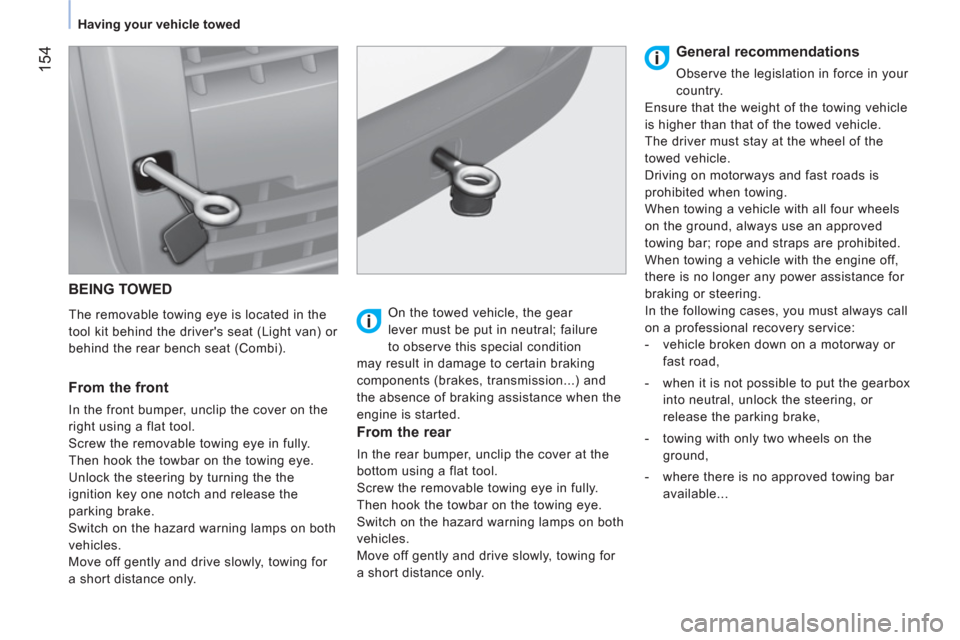
154
Having your vehicle towed
BEING TOWED
The removable towing eye is located in the
tool kit behind the driver's seat (Light van) or
behind the rear bench seat (Combi).
From the front
In the front bumper, unclip the cover on the
right using a flat tool.
Screw the removable towing eye in fully.
Then hook the towbar on the towing eye.
Unlock the steering by turning the the
ignition key one notch and release the
parking brake.
Switch on the hazard warning lamps on both
vehicles.
Move off gently and drive slowly, towing for
a short distance only.
On the towed vehicle, the gear
lever must be put in neutral; failure
to observe this special condition
may result in damage to certain braking
components (brakes, transmission...) and
the absence of braking assistance when the
engine is started.
From the rear
In the rear bumper, unclip the cover at the
bottom using a flat tool.
Screw the removable towing eye in fully.
Then hook the towbar on the towing eye.
Switch on the hazard warning lamps on both
vehicles.
Move off gently and drive slowly, towing for
a short distance only.
General recommendations
Observe the legislation in force in your
country.
Ensure that the weight of the towing vehicle
is higher than that of the towed vehicle.
The driver must stay at the wheel of the
towed vehicle.
Driving on motorways and fast roads is
prohibited when towing.
When towing a vehicle with all four wheels
on the ground, always use an approved
towing bar; rope and straps are prohibited.
When towing a vehicle with the engine off,
there is no longer any power assistance for
braking or steering.
In the following cases, you must always call
on a professional recovery service:
- vehicle broken down on a motorway or
fast road,
- when it is not possible to put the gearbox
into neutral, unlock the steering, or
release the parking brake,
- towing with only two wheels on the
ground,
- where there is no approved towing bar
available...
Page 158 of 180
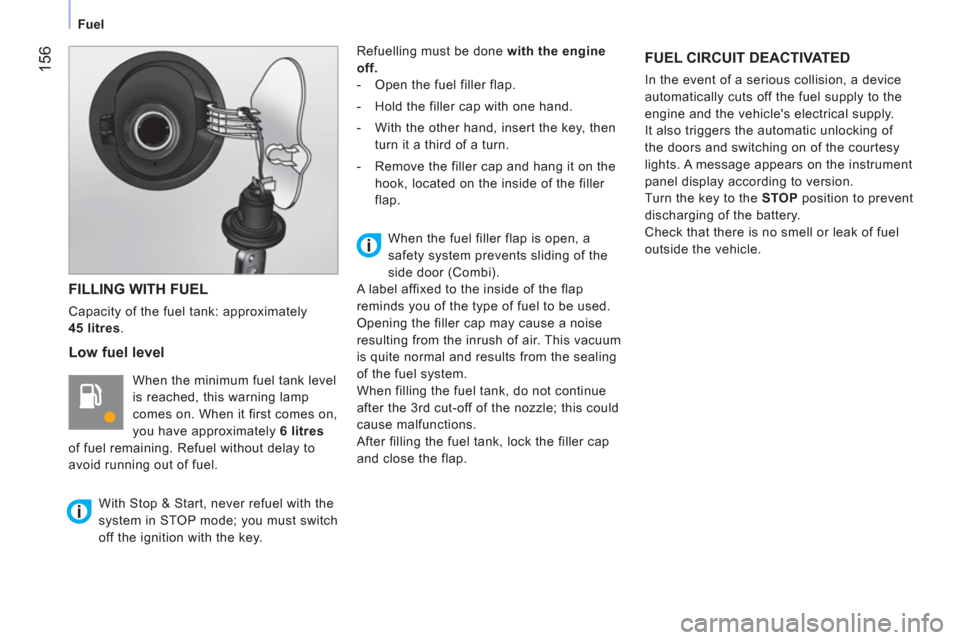
156
Fuel
FILLING WITH FUEL
Capacity of the fuel tank: approximately
45 litres.
Low fuel level
When the minimum fuel tank level
is reached, this warning lamp
comes on. When it first comes on,
you have approximately 6
litres
of fuel remaining. Refuel without delay to
avoid running out of fuel. Refuelling must be done with the engine
off.
- Open the fuel filler flap.
- Hold the filler cap with one hand.
- With the other hand, insert the key, then
turn it a third of a turn.
- Remove the filler cap and hang it on the
hook, located on the inside of the filler
flap.
FUEL CIRCUIT DEACTIVATED
In the event of a serious collision, a device
automatically cuts off the fuel supply to the
engine and the vehicle's electrical supply.
It also triggers the automatic unlocking of
the doors and switching on of the courtesy
lights. A message appears on the instrument
panel display according to version.
Turn the key to the STOP position to prevent
discharging of the battery.
Check that there is no smell or leak of fuel
outside the vehicle.
With Stop & Start, never refuel with the
system in STOP mode; you must switch
off the ignition with the key.
When the fuel filler flap is open, a
safety system prevents sliding of the
side door (Combi).
A label affixed to the inside of the flap
reminds you of the type of fuel to be used.
Opening the filler cap may cause a noise
resulting from the inrush of air. This vacuum
is quite normal and results from the sealing
of the fuel system.
When filling the fuel tank, do not continue
after the 3rd cut-off of the nozzle; this could
cause malfunctions.
After filling the fuel tank, lock the filler cap
and close the flap.
Page 159 of 180
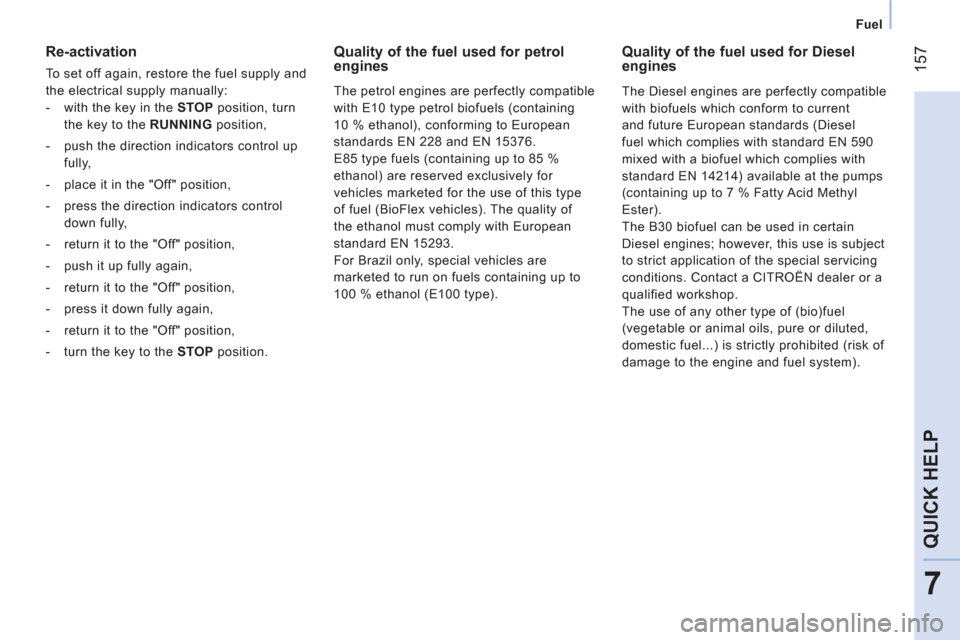
157
7
QUICK HELP
Fuel
Re-activation
To set off again, restore the fuel supply and
the electrical supply manually:
- with the key in the STOP position, turn
the key to the RUNNING position,
- push the direction indicators control up
fully,
- place it in the "Off" position,
- press the direction indicators control
down fully,
- return it to the "Off" position,
- push it up fully again,
- return it to the "Off" position,
- press it down fully again,
- return it to the "Off" position,
- turn the key to the STOP position.
Quality of the fuel used for petrol
engines
The petrol engines are perfectly compatible
with E10 type petrol biofuels (containing
10 % ethanol), conforming to European
standards EN 228 and EN 15376.
E85 type fuels (containing up to 85 %
ethanol) are reserved exclusively for
vehicles marketed for the use of this type
of fuel (BioFlex vehicles). The quality of
the ethanol must comply with European
standard EN 15293.
For Brazil only, special vehicles are
marketed to run on fuels containing up to
100 % ethanol (E100 type).
Quality of the fuel used for Diesel
engines
The Diesel engines are perfectly compatible
with biofuels which conform to current
and future European standards (Diesel
fuel which complies with standard EN 590
mixed with a biofuel which complies with
standard EN 14214) available at the pumps
(containing up to 7 % Fatty Acid Methyl
Ester).
The B30 biofuel can be used in certain
Diesel engines; however, this use is subject
to strict application of the special servicing
conditions. Contact a CITROËN dealer or a
qualified workshop.
The use of any other type of (bio)fuel
(vegetable or animal oils, pure or diluted,
domestic fuel...) is strictly prohibited (risk of
damage to the engine and fuel system).
Page 162 of 180
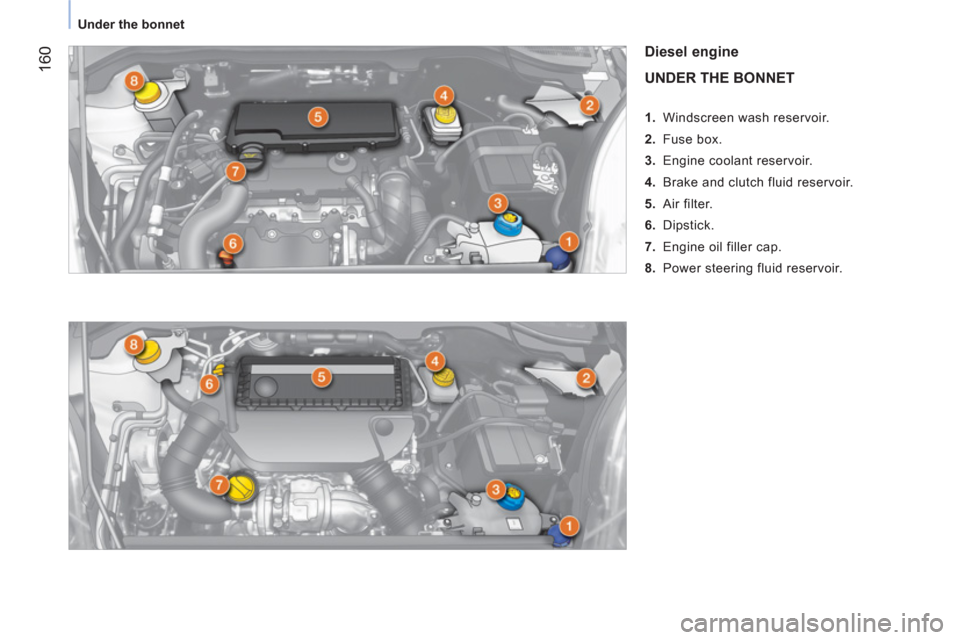
160
Under the bonnet
Diesel engine
UNDER THE BONNET
1. Windscreen wash reservoir.
2. Fuse box.
3. Engine coolant reservoir.
4. Brake and clutch fluid reservoir.
5. Air filter.
6. Dipstick.
7. Engine oil filler cap.
8. Power steering fluid reservoir.
Page 163 of 180
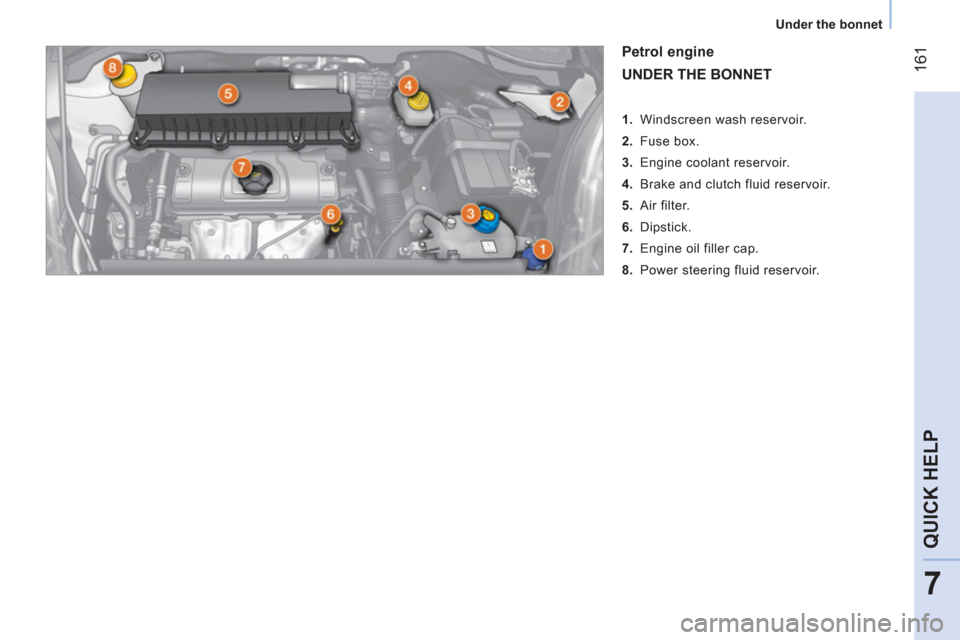
161
7
QUICK HELP
Under the bonnet
Petrol engine
UNDER THE BONNET
1. Windscreen wash reservoir.
2. Fuse box.
3. Engine coolant reservoir.
4. Brake and clutch fluid reservoir.
5. Air filter.
6. Dipstick.
7. Engine oil filler cap.
8. Power steering fluid reservoir.
Page 164 of 180
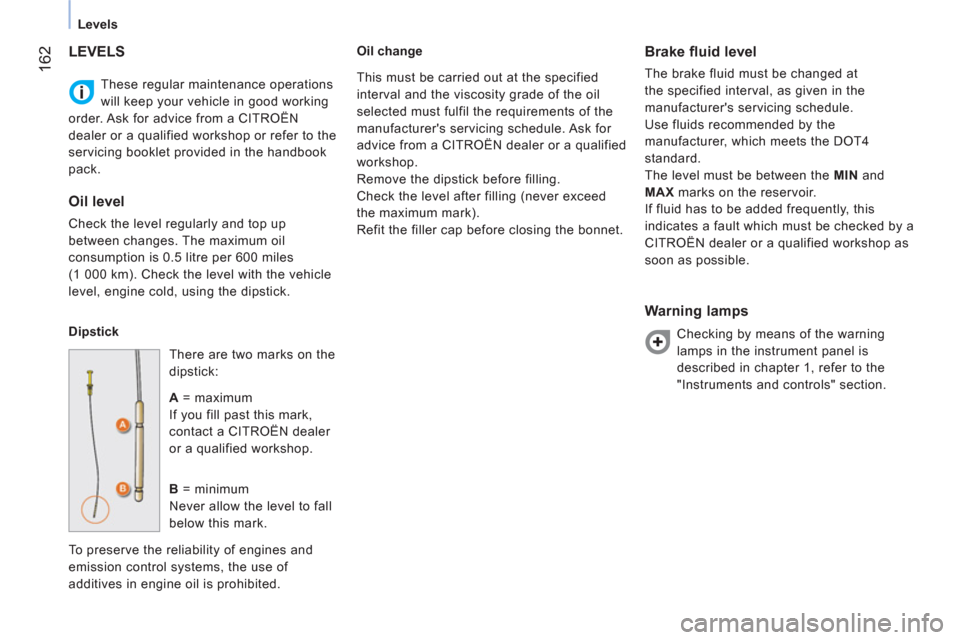
162
Levels
These regular maintenance operations
will keep your vehicle in good working
order. Ask for advice from a CITROËN
dealer or a qualified workshop or refer to the
servicing booklet provided in the handbook
pack.
LEVELS
Oil level
Check the level regularly and top up
between changes. The maximum oil
consumption is 0.5 litre per 600 miles
(1 000 km). Check the level with the vehicle
level, engine cold, using the dipstick.
Dipstick
There are two marks on the
dipstick:
A
= maximum
If you fill past this mark,
contact a CITROËN dealer
or a qualified workshop.
B
= minimum
Never allow the level to fall
below this mark.
To preserve the reliability of engines and
emission control systems, the use of
additives in engine oil is prohibited.
Oil change
Brake fluid level
The brake fluid must be changed at
the specified interval, as given in the
manufacturer's servicing schedule.
Use fluids recommended by the
manufacturer, which meets the DOT4
standard.
The level must be between the MIN
and
MAX
marks on the reservoir.
If fluid has to be added frequently, this
indicates a fault which must be checked by a
CITROËN dealer or a qualified workshop as
soon as possible.
Warning lamps
Checking by means of the warning
lamps in the instrument panel is
described in chapter 1, refer to the
"Instruments and controls" section. This must be carried out at the specified
interval and the viscosity grade of the oil
selected must fulfil the requirements of the
manufacturer's servicing schedule. Ask for
advice from a CITROËN dealer or a qualified
workshop.
Remove the dipstick before filling.
Check the level after filling (never exceed
the maximum mark).
Refit the filler cap before closing the bonnet.
Page 165 of 180
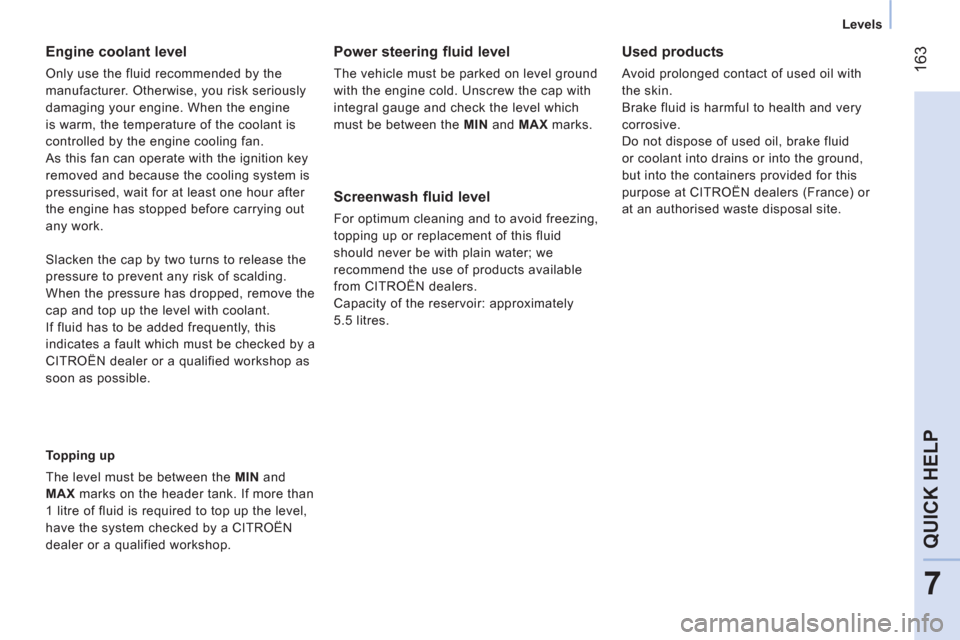
163
7
QUICK HELP
Levels
Engine coolant level
Only use the fluid recommended by the
manufacturer. Otherwise, you risk seriously
damaging your engine. When the engine
is warm, the temperature of the coolant is
controlled by the engine cooling fan.
As this fan can operate with the ignition key
removed and because the cooling system is
pressurised, wait for at least one hour after
the engine has stopped before carrying out
any work.
Topping up
The level must be between the MIN
and
MAX
marks on the header tank. If more than
1 litre of fluid is required to top up the level,
have the system checked by a CITROËN
dealer or a qualified workshop.
Power steering fluid level
The vehicle must be parked on level ground
with the engine cold. Unscrew the cap with
integral gauge and check the level which
must be between the MIN
and MAX
marks.
Screenwash fluid level
For optimum cleaning and to avoid freezing,
topping up or replacement of this fluid
should never be with plain water; we
recommend the use of products available
from CITROËN dealers.
Capacity of the reservoir: approximately
5.5 litres. Slacken the cap by two turns to release the
pressure to prevent any risk of scalding.
When the pressure has dropped, remove the
cap and top up the level with coolant.
If fluid has to be added frequently, this
indicates a fault which must be checked by a
CITROËN dealer or a qualified workshop as
soon as possible.
Used products
Avoid prolonged contact of used oil with
the skin.
Brake fluid is harmful to health and very
corrosive.
Do not dispose of used oil, brake fluid
or coolant into drains or into the ground,
but into the containers provided for this
purpose at CITROËN dealers (France) or
at an authorised waste disposal site.